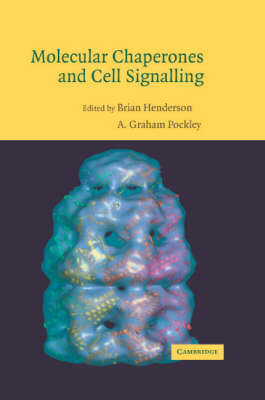
Molecular Chaperones and Cell Signalling
Cambridge University Press (Verlag)
978-0-521-83654-8 (ISBN)
This book reviews understanding of the biological roles of extracellular molecular chaperones. It provides an overview of the structure and function of molecular chaperones, their role in the cellular response to stress and their disposition within the cell. It also questions the basic paradigm of molecular chaperone biology - that these proteins are first and foremost protein-folding molecules. Paradigms of protein secretion are reviewed and the evolving concept of proteins (such as molecular chaperones) as multi-functional molecules for which the term 'moonlighting proteins' has been introduced is discussed. The role of exogenous molecular chaperones as cell regulators is examined and the physiological and pathophysiological role that molecular chaperones play is described. In the final section, the potential therapeutic use of molecular chaperones is described and the final chapter asks the question - what does the future hold for the extracellular biology of molecular chaperones?
Brian Henderson is Professor of Cell Biology at the Eastman Dental Institute, University College London and head of the Cellular Microbiology Research Group. He is the coauthor of Bacterial Disease Mechanisms (2002) and the coeditor of Bacterial Evasion of Host Immune Responses (2003). His major research interests are concerned with bacterial interactions with the host and how such interactions control inflammation and associated tissue destruction. It is through these studies that he identified that molecular chaperones are bacterial virulence factors and started his interest in the direct immunomodulatory actions of cell stress proteins. A. Graham Pockley is Professor of Immunobiology at the University of Sheffield Medical School and is head of the Immunobiology Research Unit. Professor Pockley has long-standing interests in the immunobiology of transplant rejection and his Unit is currently focussed on research relating to the biology and immunotherapeutic potential of heat shock proteins, particularly their involvement in the rejection of organ transplants and the development and progression of cardiovascular disease.
Preface; Part I. Molecular Chaperones and the Cell Stress Response: 1. Chaperone function: the orthodox view R. J. Ellis; 2. Intracellular disposition of mitochondrial molecular chaperones: Hsp60, mHsp70, Cpn10 and TRAP-1 R. S. Gupta, T. Bowes, S. Sadacharan and B. Singh; Part II. Changing Paradigms of Protein Trafficking and Protein Function: 3. Novel pathways of protein secretion G. Chimini and A. Rubartelli; 4. Moonlighting proteins: proteins with more than one function C. J. Jeffery; 5. Molecular chaperones: the unorthodox view B. Henderson and A. Shamaei-Tousi; Part III. Molecular Chaperones as Cell Regulators: 6. Cell-cell signalling properties of chaperonins A. R. M. Coates; 7. Toll-like receptor-dependent activation of antigen presenting cells by Hsp60, Hsp70 and Gp96 R. M. Vabulas and H. Wagner; 8. Regulation of signal transduction by intracellular and extracellular Hsp70 A. Asea and S. Calderwood; 9. Hsp72 and cell signalling M. Y. Sherman; 10. Heat shock proteins, their cell surface receptors and effect on the immune system T. Lehner, Y. Wang, T. Whittall and L. A. Bergmei; 11. Molecular chaperone-Cytokine interactions at the transcriptional level A. Stephanou and D. S. Latchman; Part IV. Physiological and Pathophysiological Signals: 12. Heat shock protein release and naturally-occurring exogenous heat shock proteins J. Frostegård and A. G. Pockley; 13. Hsp27 as an anti-inflammatory Protein K. Laudanski, A. De and C. Miller-Graziano; 14. Bip, a negative immune regulator involved in rheumatoid arthritis V. M. Corrigal and G. S. Panayi; Part V. Molecular Chaperones as Therapeutics: 15. Neuroendocrine aspects of the molecular chaperones ADNF and ADNP I. Gozes, I. Vulih, I. Spivak-Pohis and S. Furman; 16. Heat shock proteins regulate by both molecular and network cross-reactivity F. J. Quintana and I. R. Cohen; 17. Heat shock protein fusions: a platform for the induction of antigen-specific immunity L. Mizzen and J. Neefe; 18. Molecular chaperones as inducers of tumour immunity P. P. Bannerjee and Z. Li; Part VI. What Does the Future Hold?: 19. Gazing into the crystal ball: the unfolding future of molecular chaperones L. Hightower.
| Erscheint lt. Verlag | 18.7.2005 |
|---|---|
| Verlagsort | Cambridge |
| Sprache | englisch |
| Maße | 158 x 235 mm |
| Gewicht | 585 g |
| Themenwelt | Naturwissenschaften ► Biologie ► Biochemie |
| Naturwissenschaften ► Biologie ► Genetik / Molekularbiologie | |
| ISBN-10 | 0-521-83654-9 / 0521836549 |
| ISBN-13 | 978-0-521-83654-8 / 9780521836548 |
| Zustand | Neuware |
| Haben Sie eine Frage zum Produkt? |
aus dem Bereich


